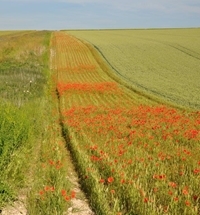 As well as being Ascot week this is also the peak hatching time for young partridge chicks. The question is will there be enough insects on farmland across the country this week to help these declining young birds survive?
As well as being Ascot week this is also the peak hatching time for young partridge chicks. The question is will there be enough insects on farmland across the country this week to help these declining young birds survive?
Crucially, young partridge chicks, which look like small bumble bees when they first hatch, will rapidly move with their parents into habitats that will provide them with at least 2,000 insects per day. Their favourite food of choice are juicy sawfly larvae but they will also feast on moth larvae as well as bugs, weevils, and even cereal aphids.
Unfortunately, this spring has been extremely cold and according to the Met Office, this has been the coldest May since 1996, with above average rainfall and this can have a dramatic impact on the number of insects available for young chicks.
Researchers from the Game & Wildlife Conservation Trust (GWCT), are therefore urging the 1,000 farmers that took part in its Big Farmland Bird Count in February to ensure that they are providing this vital insect rich habitat this summer as well as starting to plant wild bird seed crops that will help hungry birds survive the winter
But as well as encouraging farmers to grow these important wildlife habitats, the researchers from the GWCT will be keeping a watchful eye on the weather. “It is a roller-coaster ride trying to restore these declining species”, explains Professor Nick Sotherton, an entomologist from the GWCT. “This week, we will be going out to measure how insects have fared this spring, because this has a dramatic impact on our vulnerable grey partridge chicks. Two years ago, a cold spring meant that insects were in short supply and this dramatically affected the survival of partridge chicks. Without a ready supply of insects, they simply starve to death.”
Professor Sotherton continues, “Because of the low temperatures this spring, it is even more crucial that farmers have put in place the right habitats so that young chicks from this year’s clutches go on to survive and be counted as adult birds in the 2016 Big Farmland Bird Count.”
Jim Egan, from the GWCT Allerton Project Farm, who manages the GWCT’s Big Farmland Bird Count, explains, “Farmers are now acutely aware that as well as growing food they also need to look after the wildlife on their farms. Our 2015 count showed the wide range of conservation work that they are now carrying out on their farms for species such as grey partridge, lapwing, yellowhammer and others.
“Importantly the count enabled them to see what species they have on their farms and this valuable insight will help them to target future management in a much more accurate way.”
As well as growing pollen and nectar crops, which will encourage pollinators and beneficial insects, farmers will be starting to grow wild bird seed crops, which is like growing muesli for birds. This important food source will give the birds an ample supply of seeds to help them survive the early part of winter. These crops can look stunning and will contain fabulous seed bearing plants like quinoa (which we can eat too), sunflowers, millet and kale.
Jim Egan, said, “It is worth remembering that the work farmers are doing this summer will pay dividends both now and during the winter months ensuring our farmland birds have a successful breeding season and importantly a good food source as winter approaches. Hopefully with all this conservation activity taking place, farmers will be able to record even more birds when they take part in the GWCT’s Big Farmland Bird Count during the week of February 6th – 14th 2016.”
Register for the 2016 Big Farmland Bird Count
For more information on the 2016 Big Farmland Bird Count, or to register and take part in the GWCT’s bird identification days, which aim to help farmers and land managers recognise the birds on their farms, please visit the GWCT’s website at : www.gwct.org.uk/bfbc.
END
Photocaption: Providing Bed and Breakfast for birds. Creating the ideal insect-rich habitat for birds and young chicks. Photocredit: Peter Thompson, GWCT.
Notes to editors
The Game & Wildlife Conservation Trust – providing research-led conservation for a thriving countryside. The GWCT is an independent wildlife conservation charity which has carried out scientific research into Britain’s game and wildlife since the 1930s. We advise farmers and landowners on improving wildlife habitats. We employ 22 post-doctoral scientists and 50 other research staff with expertise in areas such as birds, insects, mammals, farming, fish and statistics. We undertake our own research as well as projects funded by contract and grant-aid from Government and private bodies. The Trust is also responsible for a number of Government Biodiversity Action Plan species and is lead partner for grey partridge and joint lead partner for brown hare and black grouse.
For information, contact:
Eleanor Williams
Telephone: 07592 025476
Email: press@gwct.org.uk